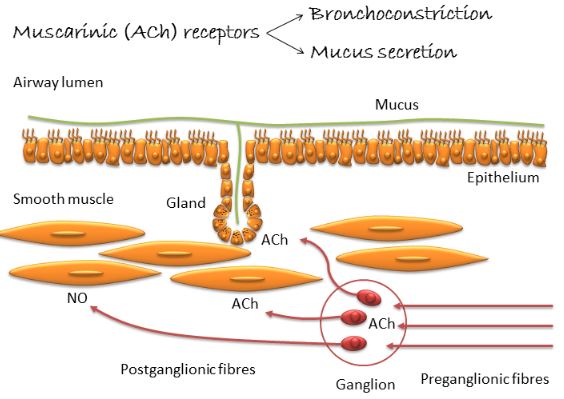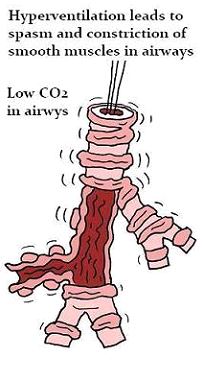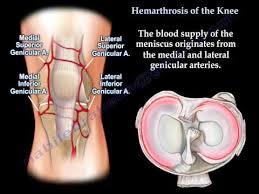Bronchospasm
Bronchospasm
This is a temporary, abnormal contraction of the muscles around the bronchus that leads to difficulty in breathing. The word bronchospasm combines the name bronchus with the action of a spasm, which is simply an involuntary muscle contraction that happens when your body reacts to certain stimuli.
A bronchospasm is no different from any other kind of spasm, except, in this case, the spasm affects the flow of air to the lungs, obstructing a very critical body function which could lead to serious consequences.
There are 2 bronchi within the respiratory tract, one leading to each lung. The bronchi are supposed to remain open in order to allow for air to pass through them and into the lungs, but sometimes they close up and lead to a bronchospasm. [1]

Image 1 – Bronchospasm Mechanism

Image 2 – Bronchospasm pathophysiology
Signs Of Bronchospasm
- difficulty breathing, often in the night or morning, but also after a period of physical exertion
- coughing
- tightness in the chest
- shortness of breath
- a wheezing sound while breathing
These symptoms can be used to identify when an individual has just experienced a bronchospasm. Since it’s a temporary action by the smooth muscle, the symptoms will often go away after some time on their own, but it’s still important to see a doctor if you experience any of these signs. [2]
What is a Bronchospasm?
To understand how a bronchospasm happens, it is necessary to first know the structure of the bronchi. The bronchi are basically hollow tubes that transport air into the alveoli of the lungs, and the central space, lumen, is relatively wide.
The shape of the bronchi is maintained by a form of cartilage called hyaline which keeps the bronchus open and avoids it from collapsing. Moving toward the lumen are smooth muscles whose primary function is to produce mucous from the seromucous glands within it.
Above these muscles is the epithelium which is just a layer made primarily of mucous and its function is to keep the bronchi lubricated. On the epithelium, there are also cilia, which trap dust and other solid particles then move them up and out away from the lungs.

Image 3 – What leads to Bronchospasm?
A bronchospasm can occur when the smooth muscles surrounding the wall of the bronchus contract suddenly closing off the passage of air into and out of the lungs. Sometimes, the muscles of the walls of the lungs can also contract and cause a bronchospasm, and other times both of these actions can occur simultaneously. [3]
Despite the overall shape of the bronchus remaining the same with the help of the surrounding cartilage, the smooth muscles around the lumen tend to relax and contract at the command of the autonomic nervous system. For example, during physical activity, these muscles stretch and contract to allow as much air to pass through as possible, while the muscles relax during rest, such as during sleep.
When the contraction of these muscles is suddenly triggered due to one of the causes below, the diameter of the lumen reduces and a bronchospasm occurs. The bronchospasm can be partial, causing the individual to experience wheezing, and this is often accompanied by a cough.
Cough is brought about by the excessive production of mucous as the bronchus tries to increase lubrication to allow for more air to pass. The cilia will try to remove the excess mucous, but since a lot is being produced, the effort is futile.
In other cases, the smooth muscles will close off the lumen completely, leading to symptoms similar to a heart attack like tightness in the chest or difficulty breathing. The lungs and diaphragm will try to force air in and out by contracting more powerfully, leading to a tightness in the chest and difficulty breathing. [4]
What causes a Bronchospasm?
There are several causes that can lead to this situation, and such an action does not occur without precedent. Some of the causes include: [5, 6]
Asthma
This is a condition where a person’s bronchial smooth muscles are more susceptible to inflammation and irritability. The main cause of this increased irritability is an allergy, which causes a person to be more sensitive to certain triggers compared to others.
Allergies occur when a person’s immunity creates antibodies which, instead of protecting the individual, attack the person’s cells. These antibodies are first formed after the individual first encounters the pathogen e.g. a bacteria or virus and the body creates harmful antibodies. Whenever the individual encounters the trigger again, their bronchial smooth muscles become instantly inflamed and contract leading to a bronchospasm.
Irritants
You may not have an allergy to a specific substance, but it can still cause your bronchi irritation and lead to a bronchospasm. One of the most common irritants is cigarette smoke as well as certain odors like fresh paint.
Infections
An infection from, say, a virus, can cause damage to the smooth muscles along your bronchi. Your body responds to this by producing certain antibodies which can cause a bronchospasm.
Exercise
If a person has asthma, or they are not used to high – intensity physical activity, this might lead to a bronchospasm.
Diagnosis
The first step in diagnosis is by an analysis of your medical history which will inform your doctor about any allergies you may have. If this does not explain the reason for your bronchospasm, further tests are taken such as X-ray and CT scans.
These are used to check for any signs of an infection or other causative agents like blood clots along your bronchi. If these are still inconclusive, pulmonary function tests are done in order to measure the strength of your breath. [7]
Treatment
Treatment options will then depend upon your diagnosis, whereby: [8]
- Bronchodilators – help to relax your smooth muscles and allow for more air to pass to your lungs
- Inhaled steroids – these reduce inflammation on your bronchi’s smooth muscle and open up the airways
- Anticholinergics – they do both the functions of the bronchodilators and the inhaled steroids
How dangerous are Bronchospasms?
The experience of a bronchospasm is very traumatic and also dangerous because the constriction of your bronchi’s smooth muscle can take some time to relax. These bronchospasms also tend to worsen with time, so you should visit your doctor as soon as you experience your first bronchospasm so they can prescribe you proper medication.
REFERENCES:
- Bronchospasm: Definition, Symptoms, Causes and Treatment Available from: http://www.normalbreathing.com/d/bronchospasm.php
- Bronchospasm Symptoms Available from: http://www.livestrong.com/article/240577-bronchospasm-symptoms/
- Bronchospasm: Causes, Pictures, Symptoms and Treatment Available from: http://www.healthsource4u.com/bronchospasm-causes-pictures-symptoms-treatment.html
- What is Bronchospasm Available from: http://www.epainassist.com/chest-pain/lungs/what-is-bronchospasm
- Bronchospasm Available from: http://www.healthcentral.com/encyclopedia/hc/bronchospasm-3168846/
- Bronchospasm Available from http://www.byebyedoctor.com/bronchospasm/
- How is Bronchospasm diagnosed? Available from: http://www.drugs.com/cg/bronchospasm.html
- Bronchospasm Treatment Available from: http://www.medicalook.com/lung_diseases/Bronchospasm.html



